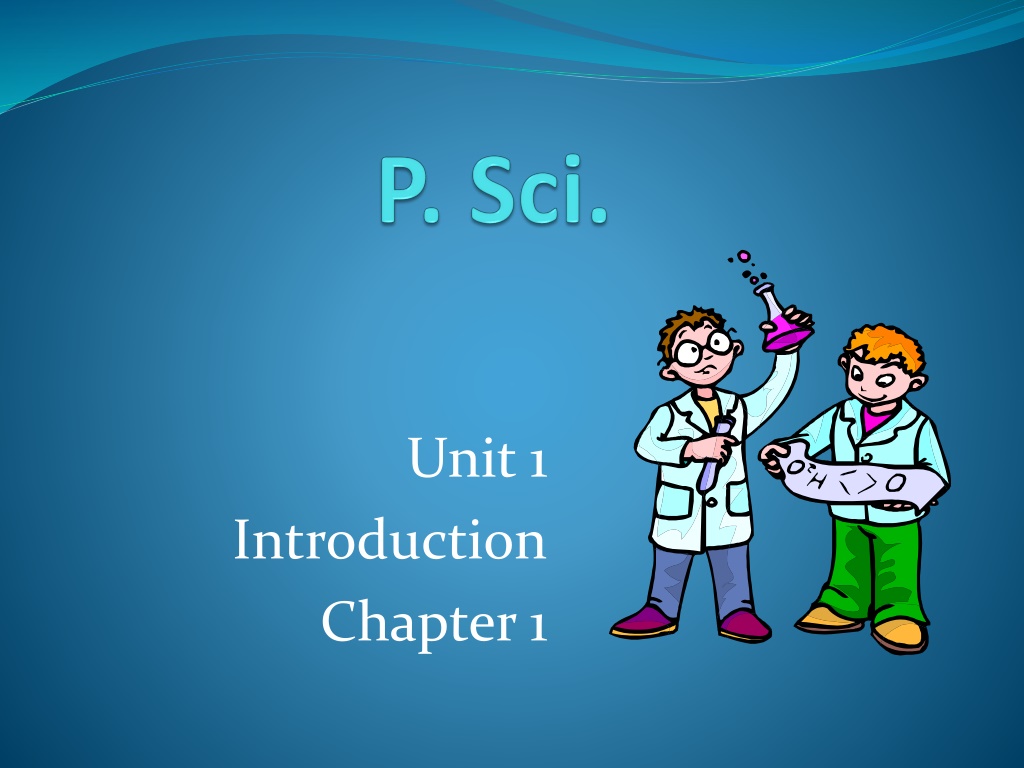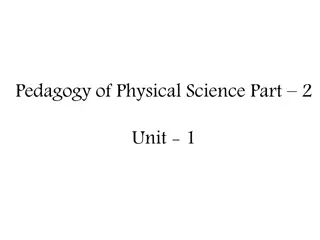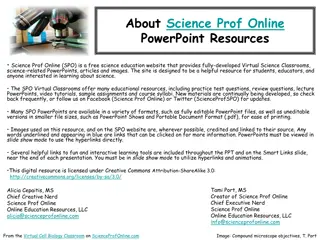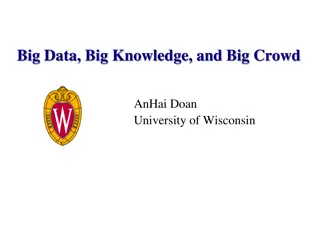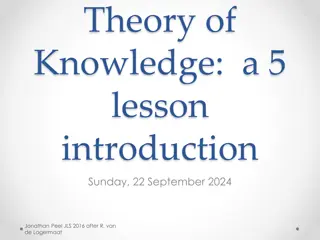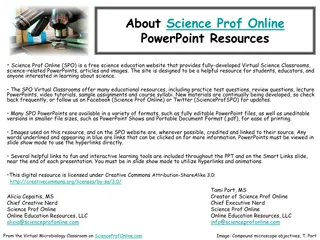Understanding Science: Introduction to the World of Knowledge
Discover the essence of science as a system of knowledge and methods for exploration. Learn about the scientific method, the relationship between science and technology, and key branches of science like chemistry and physics. Explore how science is conducted through observations and inferences, and test your understanding with practice scenarios. Engage with the fascinating world of science and enhance your critical thinking skills.
Download Presentation

Please find below an Image/Link to download the presentation.
The content on the website is provided AS IS for your information and personal use only. It may not be sold, licensed, or shared on other websites without obtaining consent from the author. Download presentation by click this link. If you encounter any issues during the download, it is possible that the publisher has removed the file from their server.
E N D
Presentation Transcript
Unit 1 Introduction Chapter 1
What is Science Science is a system of knowledge and the methods you use to find that knowledge. Science begins with curiosity and often ends with discovery
What is Science? Generally scientists believe that the universe can be described by basic rules and these rules can be discovered by careful, methodical study.
Science vs Technology Technology the application of science Science and technology are interdependent. Advances in one lead to advances in the other
Branches of Science Chemistry: The study of Matter and its changes Physics: The study of Forces and Energy
What is the Scientific Method? Scientific method refers to the techniques for investigating phenomena, acquiring new knowledge, or correcting and integrating previous knowledge It s an organized plan for gathering, organizing, and communicating information. Everyone can use the scientific method The goal of any scientific method is to solve a problem or to better understand an observed event
How Science is conducted Science is an investigation, which starts with observations leading to inferences. An observation is any information collected with the senses. An inference is conclusions or deductions based on observations.
Practice Observations: I hear people screaming I smell cotton candy, popcorn, and hamburgers I see a lot of people Inference = ?
Look at these two sets of animal tracks. List 3 OBSERVATIONS Make an INFERENCE
Now what do you think? Make 3 OBSERVATIONS Make an INFERENCE
Now what do you think? Make 3 OBSERVATIONS Make an INFERENCE
Basic steps of scientific method 1. Make an observation 2. Ask a question 3. Form a hypothesis 4.Test hypothesis 5. Analyze data/draw conclusion 6.Develop theory
Scientific Method Steps 1-3 Begins with an observation (I see smoke in the distance) that leads to a question. (what s causing the smoke) Form a hypothesis a possible answer that you can test. (Some one is burning leaves.)
Scientific Method Step 4 Conduct an Experiment A good experiment tests only one variable at a time. No experiment is a failure.
Variables Variable anything that can change in an experiment Independent variable what you change. (manipulated) Dependent variable what changes because of the independent variable. (responding) Control-what you keep the same
Scientific Method Step 5 Analyze data Data DOES NOT support hypothesis then you need to revise the hypothesis and retest Data supports hypothesis than additional testing is needed before developing a theory
Scientific Method Step 6 Scientific Theory Is an explanation that has been tested by repeated observations. Are always being questioned and examined. To be valid, a theory must continue to pass each test.
Scientific Theory (cont.) A theory must explain observations simply and clearly. Experiments that illustrate the theory must be repeatable. You must be able to predict from the theory
Scientific Law States a repeated observation about nature. Does not explain why an event happens.
Theories and Laws are not absolute Sometimes theories or Laws have to be changed or replaced completely when new discoveries are made.
Scientific Model Model is an representation of an object or event. Scientific models make it easier to understand things that might be too difficult to observe directly
Graphs A way of organizing and presenting data. Makes relationships more evident.
Line graphs Best for displaying data that change. (anything over time) Numerical vs. Numerical.
Multiple Line Graphs Best for comparing multiple values and distributions
http://t3.gstatic.com/images?q=tbn:ANd9GcSmmijP01ug2KVpwwmc9o8FWI79AGeJK0XFD5eIAKh-zzmCvZXt:beam-services.ocdsb.ca/~Richard.Taylor/sph4u/Methods/accgraph1.GIFhttp://t3.gstatic.com/images?q=tbn:ANd9GcSmmijP01ug2KVpwwmc9o8FWI79AGeJK0XFD5eIAKh-zzmCvZXt:beam-services.ocdsb.ca/~Richard.Taylor/sph4u/Methods/accgraph1.GIF What is being measured? What is independent variable? What is dependent variable? Slope (rise/run) from 0.10 s to 0.40 s
Best when comparing data for several individual items or events. Numerical vs. non-numerical Bar Graphs
http://t0.gstatic.com/images?q=tbn:ANd9GcRod286uR1r5FvNmNm7YtdPVnPhu-W_z8sIausFEF01TOUKdAbi:www.mcwdn.org/Graphs/ColGraphFW.gifhttp://t0.gstatic.com/images?q=tbn:ANd9GcRod286uR1r5FvNmNm7YtdPVnPhu-W_z8sIausFEF01TOUKdAbi:www.mcwdn.org/Graphs/ColGraphFW.gif What is being measured? What is independent variable? What is dependent variable?
Circle Graphs (pie charts) Best for displaying data that are parts of a whole.
http://t2.gstatic.com/images?q=tbn:ANd9GcSo-Pf3vdRsdRUiRWVmDrs_IF7ph938j7c1o37ERRk7i51eU1vx6g:www.mathgoodies.com/lessons/graphs/images/circle_graph_exercises.gifhttp://t2.gstatic.com/images?q=tbn:ANd9GcSo-Pf3vdRsdRUiRWVmDrs_IF7ph938j7c1o37ERRk7i51eU1vx6g:www.mathgoodies.com/lessons/graphs/images/circle_graph_exercises.gif What is being measured? What is independent variable? What is dependent variable?
Graphing Practice
Units of Measurement Scientists use the International System of Units (SI units) for measurements. When everyone uses the same units, sharing data and results is easier less mistakes.
Base Units The official SI units to measure: Length = meter (m) Volume = liter (L) Mass = gram (g) Time = seconds (s) Temperature = Kelvin (K)
Derived Unit derived units, are made from combinations of base units. Area: square meter (m2) Volume: cubic meter (m3) Density: kilograms per cubic meter (kg/m3) [a measurement of mass/volume] Pressure: pascal (Pa) [a measurement of force/area] Energy: Hertz (Hz) [a measurement of force/distance] Electric charge: coulomb (C) [is a measurement of current /time]
Metric Prefixes Metric prefixes allow for more convenient ways to express SI base and derived units. Prefix Kilo Hecto Deca Base Deci Centi Milli Symbol k h da d c m meaning 103 102 101 100 10-1 10-2 10-3
King Henry - Conversions Use the sentence King Henry Died by Drinking Chocolate Milk. to remember the order of prefixes. Kilo Hecto Deca base Deci Centi Milli meter liter gram
King Henry - Conversions Remembering the prefixes in order is key to doing ANY metric conversion Write the prefixes in order 1. 2. Count the number of JUMPS between the two prefixes 3. If going up the prefixes move the decimal to the left the same number of spaces as JUMPS 4. If going down the prefixes move the decimal to the right the same number of spaces as JUMPS
K h da base d c m Convert 2.45 hm to cm Going down the prefixes so move the decimal 4 spaces to the right 2.45 hm = 24500 cm Convert 526 mg to g Going up the prefixes so move the decimal 3 spaces to the left. 526 mg = 0.526 g
K h da base d c m Practice Convert 3.876 Kg to dg Moves to the right = 38760 dg Convert 526 dL to hL Moves to the left = 0.526 hL Convert 2.8 s to ms Moves to the right =2800 ms Convert 45 g to Kg Moves to the left = 0.045 Kg
Scientific Notation When writing very large or very small numbers, scientists use a kind of shorthand called scientific notation. This is a way of writing a number without so many zeros.
Examples: The speed of light is about 300,000,000 m/s Or 3.0 x 108 The mass of a proton is 0.000000000000000000000001673 Or 1.673 X 10-24
All you do is move the decimal so that you only have one number before the decimal. 850,000,000.0 8 5 0 0 0 0 0 0 0 . 0 = 8.5 x 108 For large numbers the exponent is positive!!
All you do is move the decimal so that you only have one number before the decimal. 0.000,000,025 0 . 0 0 0 0 0 0 0 2 5 = 2.5 x 10-8 For small numbers the exponent is negative!!
Scientific Notation Examples 0.007899 = ? Small number = - exponent 7.899 x 10-3 898745.30 = ? Large number = + exponent 8.9874530 x 105 0.00003657= ? Small number = - exponent 3.657 x 10-5 531120 = ? Large number = + exponent 5.31120 x 105
Getting numbers out of Scientific Notation Look at the exponent of the number to determine if it needs to get smaller or larger Positive exponent means the number get larger so the decimal moves to the right Negative exponent means the number gets smaller so the decimal moves to the left Add zeros to fill in any BLANK spaces
Example 1: 2.35 x 105 The exponent is positive so the number needs to get larger 2 3 5 . 2 3 5 0 0 0. or 235000 Example 2: 8.68 x 10-4 The exponent is negative so the number needs to get smaller . 8 6 8 0. 0 0 0 8 6 8 or 0.000868
Scientific Notation Examples 3.256 x 104 positive exponent = large number 3256 9.78 x 109 positive exponent = large number 978000000000 5.24 x 10-3 Negative exponent = small number 0.00524 2.41 x 10-7 Negative exponent = small number 0.000000241
Limits of Measurement Precision is a gauge of how exact a measurement is. Precise measurements are close to each other MUST have more than one measurement Accuracy is the closeness of a measurement to the actual value of what is being measured An accurate measure is close to the true or expected value MUST have true or expected value
NOT Accurate (not near center) NOT precise (not near each other) Accurate (closer to center) NOT precise (not near each other) NOT Accurate (not near center) Precise (close to each other) Accurate (Near center) Precise (close to each other)
To the right is the data collected by students during a lab. Actual Density of Aluminum is 2.70 g/cm3 Sally 1.95 g/cm3 Annie Travis 2.69 g/cm3 Jeff 2.71 g/cm3 3.12 g/cm3 1.89 g/cm3 2.73 g/cm3 2.70 g/cm3 1.92 g/cm3 2.65 g/cm3 2.25 g/cm3 1.Annie 2.Jeff 3.Sally 4.Travis 1. 2. Which students data is accurate but NOT precise? 3. Which students data is NOT accurate but IS precise? 4. Which students data is NEITHER accurate nor precise? Which students data is accurate and precise?
Density Density is defined as a unit of mass per unit volume Generally is gram/cm3 or gram/ml but other units are used. ???? ?????? ?? ? =? Example 1: Robin measured the mass of a metal cube to be 25.48 g and the cube measures 3 cm on each side. What is the cube density? ??????? = ? Given Equation Solve
